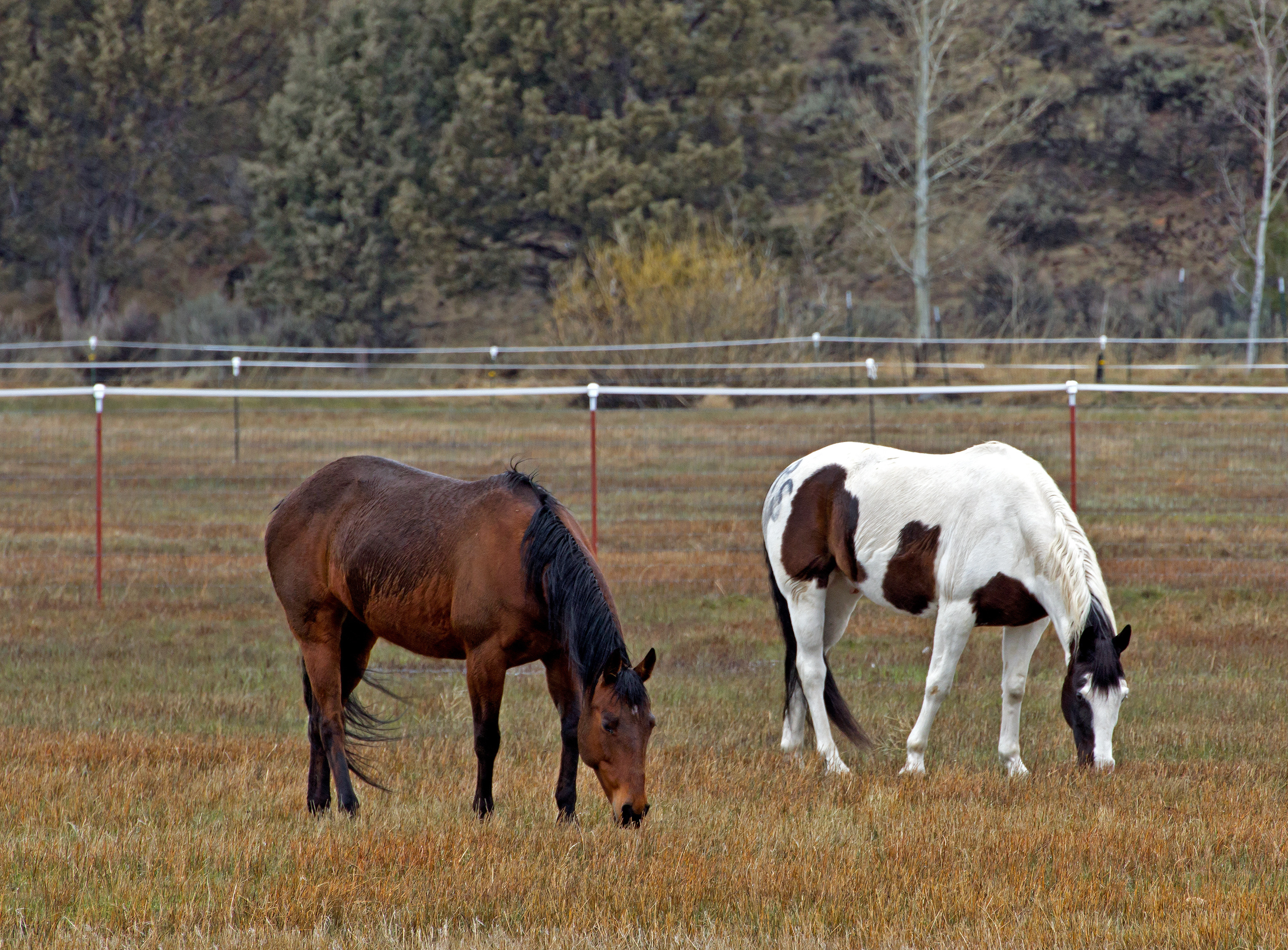Back in July, we did a fairly extensive web show on the flies that can pester horses during the summer months. However, flies are not the only nuisance that can be an issue for horse owners. There are many others, and in this article, we will take a few minutes to address what these other pesky insects are and how to go about controlling them. The insects that will be addressed in this article are biting gnats, mosquitoes, eye gnats, horse lice, ticks, horse bots and blister beetles.
Mosquitoes
 There are an estimated 50 species of mosquitoes that are known to occur in Nebraska. Mosquito larvae require a moist or wet environment to develop. They breed in wetlands, stagnant pools of water, tree holes, and a variety of other receptacles that can retain water. Damage caused by mosquitoes include pain from bites, unthriftiness, weight loss, poor reproduction and suffer from heavy blood loss. Mosquitoes can vector such diseases as Western equine encephalitis and West Nile Virus. Only the female mosquito requires a blood meal, the male mosquito feeds on plant nectar. Adult mosquitoes are strong flies and can travel long distances from their breeding sites to find a blood meal. The most effective control method available is source reduction by removing or draining mosquito breeding sites. Daily fogging for adult mosquitoes may provide relief, but is only a temporary control measure. Horses can be treated using wipe- on or sprays of insecticides with repellents to reduce mosquito numbers, but this control method must be repeated frequently.
There are an estimated 50 species of mosquitoes that are known to occur in Nebraska. Mosquito larvae require a moist or wet environment to develop. They breed in wetlands, stagnant pools of water, tree holes, and a variety of other receptacles that can retain water. Damage caused by mosquitoes include pain from bites, unthriftiness, weight loss, poor reproduction and suffer from heavy blood loss. Mosquitoes can vector such diseases as Western equine encephalitis and West Nile Virus. Only the female mosquito requires a blood meal, the male mosquito feeds on plant nectar. Adult mosquitoes are strong flies and can travel long distances from their breeding sites to find a blood meal. The most effective control method available is source reduction by removing or draining mosquito breeding sites. Daily fogging for adult mosquitoes may provide relief, but is only a temporary control measure. Horses can be treated using wipe- on or sprays of insecticides with repellents to reduce mosquito numbers, but this control method must be repeated frequently.
Biting Gnats
 “No-see-ums,” “punkies” or biting midges can be a serious pest of horses. Blood loss and irritation associated with the feeding of these very small (usually less than 0.04 inches), blood feeding flies can be significant. The immature stages of these flies complete their development in water in a variety of locations from tree holes to man-made containers to lakes and streams. Adults of these flies often are unnoticed because of their small size and because they are active at night, late evening or early morning. Direct treatment of horses with wipes or sprays containing insecticides or repellents can provide relief for the horses.
“No-see-ums,” “punkies” or biting midges can be a serious pest of horses. Blood loss and irritation associated with the feeding of these very small (usually less than 0.04 inches), blood feeding flies can be significant. The immature stages of these flies complete their development in water in a variety of locations from tree holes to man-made containers to lakes and streams. Adults of these flies often are unnoticed because of their small size and because they are active at night, late evening or early morning. Direct treatment of horses with wipes or sprays containing insecticides or repellents can provide relief for the horses.
Horse Lice
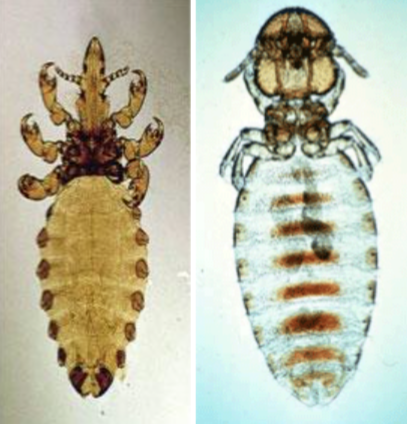 Both biting (right picture) and sucking lice (left picture) parasitize horses. Both types are host specific to horses, mules, and donkeys. Horses infested with lice usually look poorly groomed. The hair coat looks poor and the animals rub and scratch to alleviate the itching caused by feeding activity of the lice. The initial locations of infestation are generally on the head, neck, mane or tail; however, as numbers of lice increase, other areas of the body become infested. Heavy louse populations may predispose the horse to other disease conditions and reduce the vigor of the animal. Grooming provides an excellent opportunity to inspect the horse for lice. Effective louse control will require two treatments, several weeks apart. Retreatment is required since many of the control products will not kill the eggs. Always consult the product label before using an insecticide on a horse.
Both biting (right picture) and sucking lice (left picture) parasitize horses. Both types are host specific to horses, mules, and donkeys. Horses infested with lice usually look poorly groomed. The hair coat looks poor and the animals rub and scratch to alleviate the itching caused by feeding activity of the lice. The initial locations of infestation are generally on the head, neck, mane or tail; however, as numbers of lice increase, other areas of the body become infested. Heavy louse populations may predispose the horse to other disease conditions and reduce the vigor of the animal. Grooming provides an excellent opportunity to inspect the horse for lice. Effective louse control will require two treatments, several weeks apart. Retreatment is required since many of the control products will not kill the eggs. Always consult the product label before using an insecticide on a horse.
Eye Gnat
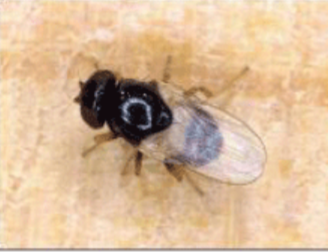 Eye gnats are very common small flies seen around the faces of horses throughout the summer months. The larvae develop in organic matter in the soil. No effective control methods are available for this pest
Eye gnats are very common small flies seen around the faces of horses throughout the summer months. The larvae develop in organic matter in the soil. No effective control methods are available for this pest
Horse Bots
Three species of bot flies damage horses. The common bot, Gasterophilus intestinalis (De Geer), the throat bot, G. nasalis (Linnaeus), and the nose bot, G. haemorrhoidalis (Linnaeus). Adults of these three species are nearly the same size as bees and are hairy bodied; however, they do not bite and do not feed at all. Bot flies lay their eggs on the hair of horses from July to September. They glue the eggs to the hair on the part of the body indicated by the common name of the different species. The common bot fly attaches eggs to the hair on the forelegs, mane, shoulders, belly, neck, and flanks. The throat bot fly attaches eggs to the hairs under the jaw of a horse. The nose bot fly lays eggs on hairs close to the lips of horses.
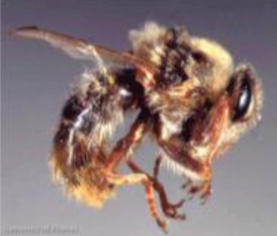 Egg laying activity causes indirect damage to horses by making them unruly and difficult to manage. Irritated and frightened horse may damage themselves, equipment and fences. Direct damage results from the larval infestations in the horse. Newly hatched larvae produce irritation as they tunnel into the gum line, tongue or lips. Horses may show signs of this irritation by rubbing their lips and noses on the ground and against fences, stock tanks or other equipment. Bot infestations in the digestive tract of the horse impair digestion and sometimes larvae are numerous enough to block the passage of material from the stomach and cause colic. Internal treatments should be administered ca. one month after the first killing frost has destroyed the adult flies. There are several internal treatment products available for controlling bots, consult a veterinarian.
Egg laying activity causes indirect damage to horses by making them unruly and difficult to manage. Irritated and frightened horse may damage themselves, equipment and fences. Direct damage results from the larval infestations in the horse. Newly hatched larvae produce irritation as they tunnel into the gum line, tongue or lips. Horses may show signs of this irritation by rubbing their lips and noses on the ground and against fences, stock tanks or other equipment. Bot infestations in the digestive tract of the horse impair digestion and sometimes larvae are numerous enough to block the passage of material from the stomach and cause colic. Internal treatments should be administered ca. one month after the first killing frost has destroyed the adult flies. There are several internal treatment products available for controlling bots, consult a veterinarian.
Ticks
 Ticks are arthropods related to insects that may become numerous and troublesome for horse in some years. There are several species of ticks in Nebraska that can become pests. The effects of ticks upon the host include inflammation, itching and swelling at the bite site, blood loss. Ticks can also transmit diseases, including anaplasmosis, equine piroplasmosis and tularemia. Tick control may be attempted through area or premise sprays. Premise sprays kills ticks which are either engorged or on foliage waiting to contact a host. On animals, control may also be successful with sprays or wipe-ons.
Ticks are arthropods related to insects that may become numerous and troublesome for horse in some years. There are several species of ticks in Nebraska that can become pests. The effects of ticks upon the host include inflammation, itching and swelling at the bite site, blood loss. Ticks can also transmit diseases, including anaplasmosis, equine piroplasmosis and tularemia. Tick control may be attempted through area or premise sprays. Premise sprays kills ticks which are either engorged or on foliage waiting to contact a host. On animals, control may also be successful with sprays or wipe-ons.
Blister Beetles
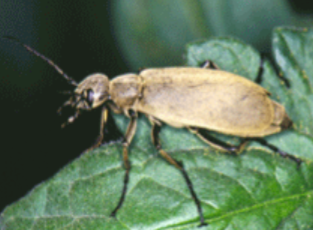 Blister beetles have a toxic secretion, cantharidin, in their blood. Cantharidin is a defensive chemical produced by blister beetles that causes severe irritation to the skin and mucous membrane of warm blooded animals. Horses are most susceptible to this toxin. Only a few beetles, eaten with hay, can cause severe illness or even death to a horse. Affected horses exhibit signs of colic, frequently void small amount of blood tinged urine, and at times have muscle tremors.
Blister beetles have a toxic secretion, cantharidin, in their blood. Cantharidin is a defensive chemical produced by blister beetles that causes severe irritation to the skin and mucous membrane of warm blooded animals. Horses are most susceptible to this toxin. Only a few beetles, eaten with hay, can cause severe illness or even death to a horse. Affected horses exhibit signs of colic, frequently void small amount of blood tinged urine, and at times have muscle tremors.
Blister beetles commonly feed on alfalfa and the flowers of a number of plants that frequently grow in hay fields. The problem occurs when hay harvesting process crushes or grinds up blister beetles and toxic parts remain in the hay that is fed to horses. Some steps can be taken to reduce the possibility of incorporating blister beetles in hay. First cutting hay seldom has blister beetles present, since it is cut in early to mid-June. That is before adult blister beetles are present in alfalfa. Blister beetle poisonings have increased since the advent of swather- conditioning equipment which runs hay between rollers and crimpers. Separate cutting followed by windrowing allows beetles to find their way out of windrows while the hay is drying and prior to baling. Hay conditioning equipment will kill many beetles as they pass through the rollers, contaminating several feet of windrow with crushed beetle parts.
